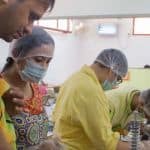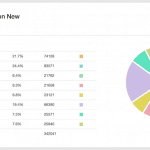How India Can Transform Its Fertilizer Subsidy Program
Fertilizer subsidy is the linchpin of India’s support system for its farmers, who in turn help provide food security for the country’s 1.3 billion people. Thanks to its growing technological capabilities, India is primed to reform its fertilizer subsidy program, making it more efficient and economical. The key lies in connecting the subsidy directly to farmers, rather than giving it to fertilizer manufacturers based on the efficiency of the fertilizer manufacturing plant, as has been the case historically.
The government is already thinking about reaching farmers directly, and here we propose optimal models to do this.
The first step would be to draw up a list of all farmers who are eligible for the fertilizer subsidy, and to set a limit on how much they can obtain. Such a list and limits don’t exist today.
A well-targeted subsidy payment would benefit farmers, by ensuring that they get what they optimally require for agriculture. It would also benefit the environment, since a cap on the availability of subsidized fertilizers would likely stop the excessive use of fertilizers which, after all, end up in the food we eat.
By successfully rationalizing its subsidy program, India can also set an example for other developing countries, like Sri Lanka and Indonesia, which also subsidize fertilizers.
The Challenges of Subsidizing Fertilizer Use in India
India is the second-largest user of fertilizer in the world, after China, thanks to a vast geographic area being cultivated by more than 150 million farmers. Subsidies on fertilizers were introduced more than 40 years ago to make them affordable to farmers – and ultimately, to ensure food security for the country.
The subsidy bill has grown exponentially over the years. From just $700 million in 1990-91, it went to nearly $11 billion in 2017-18. Fertilizer is the country’s second-largest subsidy payment, after food. But this increase in expenditure hasn’t necessarily benefited farmers. An estimated 65% of the fertilizer produced does not reach the intended beneficiaries – that is, small and marginal farmers, according to government data.
A bulk of the subsidy is given in the form of urea, which makes up 70% of all fertilizer used in India. The government sets an artificially low price for each quintal (equal to 100 kilograms) of urea, which buyers (i.e.: farmers) pay to the retailer (i.e.: fertilizer shops). (These retailers are the last-mile touch-points that sell fertilizer to farmers on a commission basis. A retailer is given a license by the state government on the basis of a pre-defined selection criteria.) The gap between this sale price and the cost of producing the urea is paid by the government to the manufacturer.
Currently, there are no restrictions on who can buy the subsidized fertilizer, or on how much they can buy. This has led to the overuse of fertilizers in cultivation, and also to the diversion of urea to other industries (like dairy, textile, paint, fisheries, etc.) and to neighboring countries like Bangladesh and Nepal (through organized black market players who buy it in the guise of farmers and sell it for a profit).
Mindful of these leakages, the Indian government has been taking steps to reform the system, using technology. It implemented the Mobile Fertilizer Management System to digitize the fertilizer distribution supply chain. And in 2016 it took its most significant step, when it piloted a Direct Benefit Transfer (DBT) system to pay the subsidy. The pilot was followed by a pan-India rollout in March of 2018.
In the past, fertilizer manufacturers would get paid most of the subsidy amount shortly after the fertilizer left their warehouses, irrespective of sales. In the new DBT system, manufacturers get paid only after the retailer has sold the fertilizer to “authenticated” individuals. That means the buyer is required to prove his identity at the time of purchasing the fertilizer. The preferred identity card is Aadhaar — a nationwide unique identity card which includes the individual’s biometric information. The buyer also has to give his fingerprints on a Point of Sale machine possessed by the retailer. Once the Point of Sale machine verifies the buyer’s identity, the retailer sells them the fertilizer at the subsidized price, the sale is recorded in the fertilizer management system, and the proportionate subsidy is remitted to the manufacturer.
The biggest benefit of the DBT system is that, for the first time, it allows the government to know exactly who is buying the fertilizer. However, it’s important to note that the system doesn’t verify if the buyer is a farmer, since there is no database of farmers in India. In our research, we found that sometimes auto rickshaw drivers (to take one example) bought fertilizers which they said was on behalf of their farmer friends.
Still, despite these issues, the DBT system has made an impact – especially in increasing transparency. At the government’s request, MSC studied the program’s progress, and we found that retailers who were relying on pilferage (which had been more profitable than genuine commissions) might have left the system.
However, there is scope for more efficiency, and the government is already talking about switching to another system — one where it would credit the subsidy directly into the bank account of farmers. The government already provides such direct transfers for cooking fuel subsidies and pension payments. In these cases, a pre-defined amount of money is deposited directly into the beneficiary’s bank account. However, replicating this model for fertilizer subsidies is more complex, partly because the government doesn’t have a list of beneficiaries (i.e.: a database of farmers).
Solutions For Connecting Subsidies Directly with Farmers
For an optimal fertilizer subsidy transfer, the first order of business would be to create a list of beneficiary farmers, including tenant farmers (who farm land owned by others, paying rent with cash or with a portion of the produce). This won’t be easy, but existing databases like the PM Kisan list (which includes the registered farmers under the Indian government’s PM Kisan cash transfer scheme) can be a starting point. The next step would be to determine how much subsidy each beneficiary is entitled to, depending on the farmers’ land holdings, geo-climatic conditions, crop types, soil health status, etc.
On the question of how the subsidy would be transferred to the farmer, crediting their bank account is a popular idea. Farmers could then buy fertilizer at market price from the retailers.
The problem is, farmers don’t prefer this approach. According to our recent assessment, 65% of farmers in India don’t want to receive the subsidy via bank transfer. This is likely because they have faced many problems with similar programs in recent years, for instance, when they were supposed to receive bank transfers in lieu of a liquefied petroleum gas subsidy. They either never received the payment or it was delayed, and farmers fear the same would happen with the fertilizer subsidy.
Another concern is that if the subsidy amount is not available on time, it would increase their financial burden. They would have to buy the fertilizer at high, non-subsidized prices, and potentially be forced to borrow money to do so. Farmers today pay Rs 295 – 325 ($4 – $4.50) for a bag of urea, whereas its non-subsidized price would be between Rs 950 -1,100 ($13 to $15). To shell out Rs 1,100 per bag upfront would be too burdensome for many of India’s small farmers.
Then there is the hassle of banking. Farmers would have to make multiple trips to banking points to withdraw cash, and then another trip to the fertilizer retailer. These trips translate to lost opportunity costs for farmers.
So, until the government can fix all the hiccups in the bank transfer model, we believe an alternative model for the subsidy transfer can fly: creating virtual accounts for farmers. This wouldn’t be a bank account, but rather a digital record of how much fertilizer subsidy a farmer is entitled to, how much he has used, and what is remaining.
Here’s how it would work: A virtual account would be opened for all eligible beneficiaries on a government platform. At the beginning of India’s two major crop seasons, namely the kharif and rabi seasons, the government would credit the subsidy to the farmer’s virtual account. The farmer would get an SMS or a call on his registered mobile number, showing how much he is entitled to. (Most farmers in India now have access to a mobile phone.)
To buy the fertilizer, the farmer would authenticate himself with his Aadhaar card and the Point of Sale machine available at the retailer, then pay the subsidized amount. The gap between what he pays and the cost of manufacture would be deducted from the farmer’s virtual account. It would be transferred to the fertilizer manufacturer within a stated period of time.
This system would have two advantages. It wouldn’t create additional hassles for the farmer. He’d continue buying the fertilizer at the subsidized rate, without having to worry about whether the subsidy has reached his bank account or not. At the same time, the government would have better information about who is using the subsidy and by how much. In a way, it would further refine the Direct Benefit Transfer system that is in place now.
We recommend that the government commence a pilot for this model, since the infrastructure is ready. Once the banking and payment infrastructure is strengthened, the government can create a pilot for direct bank transfers.
Once farmers have had the opportunity to experience both models, the government will be able to determine the most suitable model for all stakeholders. We believe that both farmers and the Indian government will be quick to recognize the mutual benefits of this approach.
Ritesh Rautela is a Senior Manager, and Anurodh Giri is an Associate Partner at MSC (a NextBillion partner).
Photo credit: Well-Bred Kannan (WBK Photography)
- Categories
- Agriculture, Technology




